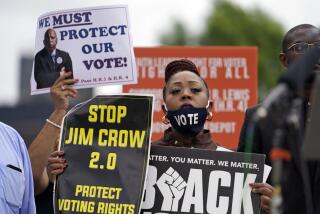Black America’s Long Fight Against Vote...
- Share via
Peggy Connor is a soft-spoken woman who ran a beauty shop in the black community of Hattiesburg, Miss., in the 1960s. She was active in the Mississippi Freedom Democratic Party, which challenged the state’s all-white delegation to the 1964 Democratic Party national convention and shook the party to its roots. It is her name that designates what, to paraphrase a line from the show “Guys and Dolls,” became possibly the longest-running permanent floating redistricting case in United States history.
Connor v. Johnson changed Mississippi’s political map. That would be significance enough, given that Mississippi represented the heart and soul of the civil rights movement and white resistance to it. But the case had national impact as well, as attorney Frank R. Parker skillfully explains in his clear and detailed book, “Black Votes Count: Political Empowerment in Mississippi After 1965.” Attorneys such as Parker, Alvin Bronstein and others who worked in Mississippi used this and other cases to document the ongoing need for the Voting Rights Act of 1965 even after black people secured the basic right to register.
Parker’s book, along with “Minority Vote Dilution,” edited by Chandler Davidson, outlines the tactics states and local governments used to evade the full impact of black and Latino voting rights after 1965 and how those groups fought back through the courts. Parker now directs the voting rights project of the Lawyers Committee for Civil Rights Under Law. Davidson is a professor of sociology at Rice University and has been a consultant in many cases involving vote dilution.
It should be noted that these books are not describing ancient history. Harvey Gantt, the black former mayor of Charlotte, N.C., faced a June runoff primary for the Democratic nomination for the U.S. Senate even though he got the most votes in the primary. Nine states, eight of them Southern, require that candidates who fail to win a majority vote in a primary election face a runoff before the general election. In the runoff, a white vote that may have been fragmented in the primary can unify against the black candidate. In primaries in the rest of the states, whoever wins the most votes becomes the party candidate then and there. Gantt won both primary and runoff, however, and will face Republican Sen. Jesse Helms in November in a race that will undoubtedly attract national attention. But with many whites still unwilling to vote for a black candidate, blacks clearly have a better shot at winning office without such double jeopardy.
At first glance, these books may look like so much “inside baseball”--detail that only an inveterate fan of politics could love. But the books show, chapter and verse, how states such as Mississippi kept blatantly obstructing minority political progress long after the nation said, “Stop it!” Parker’s book, especially, answered a question that kept coming up as I did research on Fannie Lou Hamer and other extraordinary civil rights workers who fought for change in that state: Why, after all their work, were so many of the state’s officeholders still white?
The Voting Rights Act passed in 1965. In 1966 alone, Parker tells us, Mississippi legislature “gerrymandered the congressional district lines to prevent the election of a black member of Congress; denied black voters representation in the State Legislature by creating larger, multimember state legislative districts in which black-voting strength was diluted; authorized counties to switch to at-large county school boards to prevent the election of black candidates; abolished elections for county school superintendents in numerous counties, and increased the qualifying requirements for independent candidates to prevent black independents from running for office.” It was a massive shift “from denial to dilution,” and Mississippi activists led the way for the rest of the country in resisting such changes.
The case of Connor v. Johnson was just one portion of the activists’ own massive resistance. When first filed in October, 1965, it challenged Mississippi’s practice of having several representatives chosen in each legislative district in at-large elections, meaning that everyone voted for all candidates. White voters invariably outnumbered black registrants in these districts. Only whites got elected because few of them would vote for black candidates.
The case stayed in the courts for 14 years and required nine trips to the Supreme Court. Once the multimember districts were thrown out, the activists then had to challenge the way Mississippi drew the district lines. Finally in 1979, using newly drawn single-member districts, Mississippi voters elected 17 blacks to the State Legislature. Even in a state with 35% black population, it took until 1986 before black lawyer Mike Espy was elected to Congress. There are still majority-black counties in the cotton country of the Delta that have only one black member (out of five) on their boards of supervisors.
Nationally, Connor v. Johnson and other cases have led the Supreme Court to issue rulings that protect against diluting minority votes. They have also buttressed arguments for extending and strengthening the Voting Rights Act despite significant opposition from both the Nixon and Reagan administrations, the latter as recently as 1982.
Where “Black Votes Count” examines Mississippi microscopically, “Minority Vote Dilution” presents the broader picture. It contains essays on vote denial after the Civil War, on the role of at-large elections and slate-making groups in diluting minority votes, on weaknesses in enforcing the Voting Rights Act, and on questionable court decisions that led Congress to write into that law firm statements on what evidence is--and is not--required to prove vote dilution. There is also a fascinating account of how so-called good government reforms, including at-large elections, actually were efforts of business communities to control city government at the expense of immigrants and minorities.
Each reviewer inevitably wants a little something more than the author chose to include. In reading Parker’s book, I wanted to know about the people who brought the suits, who risked jobs and perhaps even their lives. Nowhere, for example, do you even find Peggy Connor’s first name. She deserves at least that recognition. The information in the first paragraph of this review comes from a conversation this spring in Hattiesburg. Even though she was at less economic risk than many other people, she told me that whites still tried to scare off some of her beauty shop’s customers. But Parker’s is after all a lawyer’s book, not a journalist’s, and a fine one at that.
Mississippi is still wrestling with its past and its future. More than anything, “Black Votes Count” shows how constant the struggle is, how many men and women must get involved and stay involved, how community people need lawyers and lawyers need community people, and how change can occur if they are all in it for the long haul. And it has been, and still is, a long haul, one that has been instructive for the entire nation.
More to Read
Get the L.A. Times Politics newsletter
Deeply reported insights into legislation, politics and policy from Sacramento, Washington and beyond. In your inbox twice per week.
You may occasionally receive promotional content from the Los Angeles Times.










